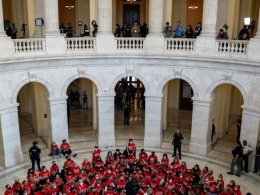Anwar Al Awlaki: ISIS’ digital caliph preaching from beyond the grave
Just hours after Abdul Razak Ali Artan, the 18-year-old Somali refugee who rammed his car into the sidewalk at Ohio State University aiming to kill pedestrians and then subsequently exiting his vehicle and stabbing his victims with a butcher knife, authorities went to his Facebook page where they would find a number of posts allegedly written by Artan expressing anger and frustration with Americans and hailing the radical teachings of who he calls “our hero Imam Anwar Al Awlaki.”
But just who is Awlaki, the notorious American-born Al Qaeda cleric, and why are jihadis still referencing his teachings in their left-behind diaries, notebooks and rants more than five years after his death?
Awlaki, or ‘Sheikh Anwar’ as he was often called, specifically targeted Western jihadi-wannabes and lone-wolf potentials. With perfect command of both English and Quranic Arabic, he penetrated deep into the hearts and minds of young radicals everywhere. And he had just one clear message: It is the duty of every Muslim to kill Americans.
He put out dozens of CDs and videos branding his hatred for the West and passion for extremism into talking points on just about every subject. He left his legacy as the digital imam.
Despite a 2010 U.S. Congress request to Google, the parent company of YouTube, ordering the removal of his material, searches for “Awlaki Lectures” or “videos” still generate tens of thousands of results.
In September 2011, exactly a decade after the 9/11 attacks, Awlaki was killed in a CIA drone strike in Yemen.
Aptly described as “the Bin Laden of the internet” by Saudi broadcaster Al Arabiya, Awlaki’s propaganda and posthumous success in inspiring terrorism appear to make him far more influential in death than during his life time.
It would be almost three years later that the Islamic State would physically emerge with the announcement of a Caliphate and a center in Raqqa, Syria, but the legacy of Awlaki, though belonging to rival terror group Al Qaeda, was easily and seamlessly adopted as an iconic ISIS figure, all-too-frequently quoted by self-radicalized devotees.
In September, when NY/NJ bomber Ahmad Khan Rahimi, the 28-year old Afghan immigrant detonated bombs in multiple locations, authorities found that he made references to Awlaki as his inspiration to carry out a terror attack on U.S. soil.
"I looked for guidance and [praise be to God] guidance came. Sheikh Anwar [al-Awlaki,] Brother Adnani ... said it clearly attack the kuffar [unbelievers] in their backyard," an entry in a blood-soaked journal found on Rahimi stated.
And Awlaki’s legend only appears to be growing, particularly as ISIS has made frequent reference to his rants calling for the establishment of an Islamic caliphate in Iraq in their propaganda material as early as 2014.
Awlaki’s teachings also appear to have influenced several terrorist attackers in the U.S., that were later claimed by the Islamic State, including Syed Rizwan Farook who carried out the San Bernardino attack in December 2015 and similarly, the attack at the “Prophet Mohammed cartoon contest” in Garland, Texas.
“Awlaki drew in the U.S. and Western-born Jihadists and those who live in the West to display their importance in the global network,” Dr. Walid Phares, Fox News terrorism expert and the author of Future Jihad said. “He demonstrated that the movement was able to mutate inside the U.S. without elements coming from the outside.”
Born in La Cruces, New Mexico in 1971 to Yemeni parents, Awlaki spent seven years in the U.S. before returning with his family to Yemen, where he spent the next 11 years and then returned to attend college in the U.S. at age 19.
Awlaki quickly turned to preaching; First with the Denver Islamic Society and then as an imam in San Diego. According to U.S. officials, two of the 9/11 hijackers attended his sermons at his San Diego mosque.
In 2000, he moved to Washington D.C. to study for a doctorate in education while also serving as a Muslim Chaplain at George Washington University.
Awlaki left the U.S. in late 2002, and after a short visit to the U.K., moved to Yemen in early 2004 where he more openly associated with Al Qaeda.
Coming under the radar of FBI agents, Awlaki was interviewed regarding possible ties to the 9/11 terror attackers while serving time in a Yemeni jail for the kidnapping of a Shiite teenager and an Al Qaeda plot to kidnap a U.S. military attaché.
Following his release later that year, an emboldened Awlaki stepped up distribution of his jihadi ideals in English, distributing CD’s of his lectures and setting up a blog and a Facebook page, creating guides such as “44 ways to support jihad.”
“What is important about Awlakis initial statements and narrative is that he demonstrated that as a U.S. raised and educated Jihadist he could express sophisticated Jihadi speech in American English and show that as a Western born Jihadist he can lead the movement or parts of it in their war against the US and allies,” Dr. Phares said.
It may have been Awlaki who was one of the main architects of Al Qaeda’s English language “Inspire” magazine, which regularly publishes tutorials on lone-wolf jihad, including homemade bomb recipes, and frequent calls for attacks on the U.S.
Awlaki was directly linked with at least two terror attacks on the U.S.; Communicating with Fort Hood terrorist Nidal Hassan who killed 13 in a mass shooting terror attack in 2009 and failed “underwear bomber” Umar Farouk Abdulmutallab who tried to bring down a U.S. airliner on Christmas day 2009. Abdulmutallab trained at Al Qaeda’s terrorist camps in Yemen and was said to have been inspired by the late Al Qaeda leader.









